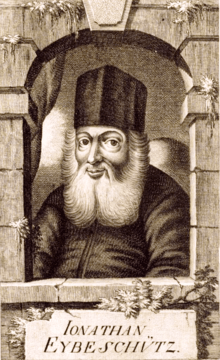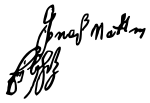Jonathan Eybeschutz
Rav Jonathan (Yonoson יונתן) Eybeschütz (also Eibeschutz or Eibeschitz; 1690 in Kraków – 1764 in Altona), was a Talmudist, Halachist, Kabbalist, holding positions as Dayan of Prague, and later as Rabbi of the "Three Communities": Altona, Hamburg and Wandsbek. With Rav Jacob Emden, he is well known as a protagonist in the Emden–Eybeschütz Controversy.
Jonathan Eybeschütz | |
|---|---|
 | |
| Personal | |
| Born | 1690 |
| Died | 1764 (aged 73–74) |
| Religion | Judaism |
| Spouse | Elkele Spira |
| Children | Wolf Jonas Eybeschutz |
| Parents |
|
| Signature |  |
Biography
Rav Eybeschütz's father Nosson Nota[1] was the rabbi in Ivančice (German: Eibenschütz, sometimes Eibeschutz), Habsburg Moravia. Rav Eybeschütz was a child prodigy in Talmud; on his father's death, he studied in the yeshiva of Meir Eisenstadt in Prostějov (Prossnitz), and then later in Holešov (Holleschau). He also lived in Vienna for a short time. He married Elkele Spira, daughter of Rabbi Isaac Spira, and they lived in Hamburg for two years with Mordecai ha-Kohen, Elkele's maternal grandfather.
At the age of eighteen, Rav Eybeschütz was appointed rabbi of Mladá Boleslav, where he stayed for three years, afterward settling in Prague in 1700 and becoming head of the yeshivah and a famous preacher. The people of Prague held Rav Eybeschütz in high esteem and he was considered second there only to Dayan David Oppenheim.
In Prague, Rav Eybeschütz received permission to print the Talmud—but with the omission of all passages contradicting the principles of Christianity in consultation with Dayan David Oppenheim. Legends and rumors seeking to discredit the event said that he did this without the consultation of the Rabbis of Prague, and they revoked the printing license.
Already in Prague 1724, he was suspected of being a Sabbatean. He even got up on Yom Kippur to denounce the Sabbatean movement, but he remained suspected.[2] Therefore, In 1736, Rav Eybeschutz was only appointed dayan of Prague and not chief rabbi. He became rabbi of Metz in 1741. In 1750, he was elected rabbi of the "Three Communities:" Altona, Hamburg, and Wandsbek.
He was "an acknowledged genius" in at least three separate areas of Jewish religious creativity: Talmud and Jewish law (halakhah); homiletics (derush) and popular preaching; and Kabbalah. "He was a man of erudition, but he owed his fame chiefly to his personality. Few men of the period so profoundly impressed their mark on Jewish life."[3] His granddaughter was the Breslau poet and intellectual Lucie Domeier, born Esther Gad.
Sabbatian controversy
Rav Eybeschütz again became suspected of harboring secret Sabbatean beliefs because of a dispute that arose concerning the amulets which he was suspected of issuing. It was alleged that these amulets recognized the Messianic claims of Sabbatai Zevi.[3] The controversy started when Rav Yaakov Emden found serious connections between the Kabbalistic and homiletic writings of Rav Eybeschutz with those of the known Sabbatean Judah Leib Prossnitz, whom Rav Eybeschütz knew from his days in Prossnitz.[2] Rabbi Jacob Emden accused him of heresy.[3] The majority of the rabbis in Poland, Moravia, and Bohemia, as well as the leaders of the Three Communities supported Rav Eybeschütz: the accusation was "utterly incredible"—in 1725, Rav Eybeschütz was among the Prague rabbis who excommunicated the Sabbateans. Others suggest that the Rabbis issued this ruling because they feared the repercussions if their leading figure, Rav Eybeschütz, was found to be a Sabbatean. Recent evidence has produced the actual amulets and their alleged connection to Sabbatean amulets.[4]
In 1752, the controversy between Rav Emden and Rav Eybeschütz raged. In December of that year, the Hamburg government banned any more discussion of the amulets, the Senate of Hamburg suspended Rav Eybeschütz, and many members of that congregation demanded that he should submit his case to rabbinical authorities. At this point he was defended by Carl Anton, a convert to Christianity, but a former disciple of Rav Eybeschütz.[5]
The controversy was a momentous incident in Jewish history of the period—involving both Rav Yechezkel Landau and the Vilna Gaon—and may be credited with having crushed the lingering belief in Sabbatai current even in some Orthodox circles.[3]
In 1760, the quarrel broke out once more when some Shabbatean elements were discovered among the students of Rav Eybeschütz' yeshivah. At the same time his younger son, Wolf Jonas Eybeschutz, presented himself as a Shabbatean prophet, and was close to several Frankists, with the result that the yeshivah was closed.[6]
According to Jacob Katz, Rav Jonathan Eybeschütz's grandson was rumored to be Baron Thomas von Schoenfeld, an apostate Jew who inherited his grandfather's collection of Sabbatean kabbalistic works. He eventually left the Sabbatean movement and founded a Masonic lodge called the Asiatische Bruder, one of four Illuminati lodges in Vienna. After his uncle's death on August 10, 1791, he was offered the leadership of the Frankist movement which he refused. Katz disputes this claim however, saying that Baron Thomas von Schoenfeld was a member of the Dobruschka family of Brno and was in no way related, either by blood or marriage, to Rav Eybeschutz. According to Gershom Scholem, the ideology of the Asiatic Brethren mixed Kabbalistic and Sabbatean ideas jumbled together with Christian theosophic doctrines.[7]
Some of Rav Eybeschutz's descendants are the Yiddish novelist and Holocaust survivor Chava Rosenfarb (1923–2011),, Rav Chaim Kreiswirth of Antwerp, Belgium, and Rav Shmuel Wosner (1913–2015), a prominent Haredi rabbi and posek ('decisor of Jewish law') who lived in Bnei Brak, Israel.
Works
Thirty of his works in the area of Halakha (Jewish law) have been published. In addition, several of his works on homiletics, teaching methodology, and Kabbalah are currently in print. Only one of his works was published in his lifetime. The posthumous printing of so many of his works is testimony to his influence on his contemporaries through his oral teachings and his personality.
- Homiletics (derush) and popular preaching::
- Ya'arot Devash a frequently quoted collection of the sermons of Rabbi Eybeschutz.
- Tiferet Yehonatan on the weekly Torah portion
- Midrash Yehonatan on the weekly Torah portion
- Ahavat Yehonatan on the weekly Haftarah
- Shirei Mitzvot, the 613 commandments in rhymed acrostics.
- Notes on the Passover Haggadah, as well as Perush al Piska Had Gadya on the poem Had Gadya
- On Talmud and halakhah::
- Chasdei Yehonatan, Pilpulim on assorted Sugyas of Talmud and halakhah.
- Novellae to Shulchan Aruch: Urim ve-Tummim on Choshen Mishpat; Kereti u-Peleti on Yoreh De'ah; Sar ha-Alef on Orach Chayim.
- Notes on Maimonides' Mishneh Torah: Binah la-Ittim and Chiddushim al Hilkot Yom Tov both dealing with the holy days, and both published by his students, based on notes taken from his lectures; Bene Ahuvah on the matrimonial laws.
- Tiferet Yisrael, notes on the rabbinical laws of niddah (regarding menstruation), with additions by the editor, his grandson Israel.
- Matuk MidVash, notes on the rabbinical laws of shabbos.
- On Kabbalah::
- Shem Olam, a collection of letters on the Kabbalah
Rabbi Eybeschutz also wrote Luchoth Edut (Tablets of Testimony), in which he describes the whole dispute and attempts to refute the charges against him. It includes also the letters of recommendation which he had received from leading rabbis who came to his defense. In January 2014, Maggid Books, a division of Koren Publishers Jerusalem published "Derash Yehonatan: Around the Year with Rav Yehonatan Eybeshitz" by Rabbi Shalom Hammer. This work is one of the first English translations of Rabbi Eybeshutz's writings.
References
- "Rabbi Jonathan Eybeschutz - (5450-5524); 1690-1764".
- Moshe Arie Perlmutter, R.Yehonatan Aibeshits ve-yahaso el ha-Shabtaut : hakirot hadashot 'al yesod ketav ha-yad shel s.va-avo ha-yom el ha-'ayin
-

- Sid Leiman/Simon Schwarzfuchs, New Evidence on the Emden-Eybeschütz Controversy. The Amulets from Metz, in: Revue des Etudes Juives 165 (2006),
- "Kurze Nachricht von dem Falschen Messias Sabbathai Zebhi," etc. (Wolfenbüttel, 1752)
- Carmilly-Weinberger, Moshe. Wolf Jonas Eybeschütz - An "Enlightened" Sabbatean in Transylvania. In: Studia Judaica, 6 (1997) 7-26
- Katz, Jacob (1970). Jews and Freemasons in Europe 1723–1939. Cambridge: Harvard University Press. ISBN 0-674-47480-5.
Sources
- Moshe Perlmutter, R.Yehonatan Aibeshits ve-yahaso el ha-Shabtaut : hakirot hadashot 'al yesod ketav ha-yad shel s.va-avo ha-yom el ha-'ayin (Tel Aviv:1947 )
- Carl Anton, Period documents concerning the Emden/Eibeschuetz controversy. (Reprint 1992)
- Elisheva Carlebach, The pursuit of heresy : Rabbi Moses Hagiz and the Sabbatian controversies (Columbia 1990)
- Gershom Scholem, Meḥḳere Shabtaʼut (1991)
- Sid Leiman/Simon Schwarzfuchs, New Evidence on the Emden-Eibeschiitz Controversy. The Amulets from Metz, Revue des Etudes Juives 165 (2006),
- Sid Z. Leiman, "When a Rabbi Is Accused of Heresy: R. Ezekiel Landau's Attitude toward R. Jonathan Eibeschuetz in the Emden- Eibeschuetz Controversy in FROM ANCIENT ISRAEL TO MODERN JUDAISM Edited by Jacob Neusner
- Leiman, Sid (Shnayer) Z. When a rabbi is accused of heresy : the stance of the Gaon of Vilna in the Emden-Eibeschuetz controversy in Me'ah She'arim (2001) 251-263
- Leiman, Sid (Shnayer) Z. When a rabbi is accused of heresy : the stance of Rabbi Jacob Joshua Falk in the Emden-Eibeschuetz controversy. Rabbinic Culture and Its Critics (2008) 435-456
- Moshe Carmilly-Weinberger, Wolf Jonas Eybeschütz - an "Enlightened" Sabbatean in Transylvania Studia Judaica, 6 (1997) 7-26
- Yehuda Liebes "A Messianic Treatise by R. Wolf the son of R. Jonathan Eibeschutz." Qiryat Sefer 57 (1982/2)148-178.
External links
| Wikimedia Commons has media related to Jonathan Eybeschutz. |
- Eybeschütz, Jonathan, jewishencyclopedia.com
- Rabbi Jonathan Eybeschutz, chabad.org
- Jonathan Eibeschutz, jewishvirtuallibrary.org
- detailed Hebrew article by Hayyim Rabinovitz in Sinai 1964